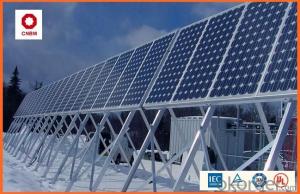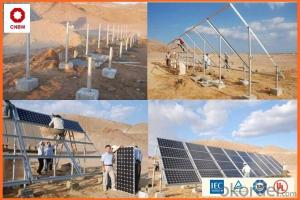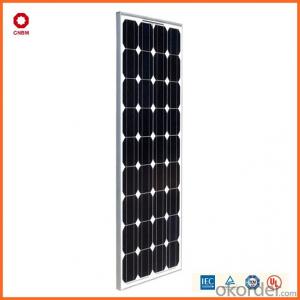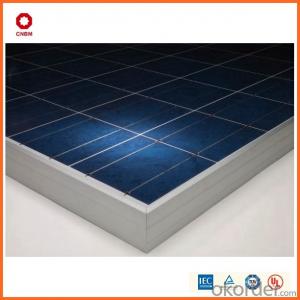105w Small Solar Panels in Stock China Manufacturer
- Loading Port:
- China main port
- Payment Terms:
- TT OR LC
- Min Order Qty:
- 1 watt
- Supply Capability:
- 10000000 watt/month
OKorder Service Pledge
OKorder Financial Service
You Might Also Like
Item specifice
Product Description:
Hot Sale !!! Quality and Safety of Small Poly Solar Panel 5w~150w
1. Rigorous quality control meets the highest international standards.
2. High-transmissivity low-iron tempered glass, strong aluminium frame.
3. Using UV-resistant silicon.
4. IS09001/14001/CE/TUV/UL
Warranties of Small Poly Solar Panel 35~85w
1. 10 years limited product warranty
2. 15 years at 90% of the minimal rated power output
3. 25 years at 80% of the minimal rated power output
Specification
Characteristics of Poly solar panels CNBM (245-320W) | |||||
Max Power Voltage Vmp(V) | 30.3 | 30.8 | 31.1 | 31.4 | 31.85 |
Max Power Current Imp(A) | 7.60 | 7.64 | 7.73 | 7.81 | 7.85 |
Open Circuit Voltage Voc(V) | 36.1 | 36.6 | 37 | 37.3 | 37.68 |
Short Circuit Current Isc(A) | 8.50 | 8.55 | 8.65 | 8.75 | 8.85 |
Max Power Pm(W) | 230W | 235W | 240W | 245W | 250W |
Temperature Coefficient of Cells Poly solar panels CNBM (245-320W) | |
NOCT | 45± 2 |
Temperature Coeffucients of Isc | 0.0492 |
Temperature Coeffucients of Voc | -0.3374 |
Temperature Coeffucients of Voc | -0.4677 |
Mechanical Data of Poly solar panels CNBM (245-320W) | |
Dimension | 1638 × 982 × 40 mm |
Weight | 19.5 kg |
No. of Cells and Connections | 60 (6 ×10) |
Tolerance | 0 ~ + 5 W |
Cell | Monocrystalline Cell 156 × 156 mm |
Packing | 624 Pcs/40ft(H) Container |
Limits of Poly solar panels CNBM (245-320W) | |
Operating Temperature | -40 to +85 |
Storage Temperature | -40 to +85 |
Max System Voltage | 1000VDC(IEC) / 600VDC(UL) |
Features of our products:
• High conversion efficiency mono/poly-crystalline amorphous silicon solar cells
• Modules incorporate high performance bypass diodes to minimize the power drop caused by shading
• High transmittance, low-iron tempered glass
• High performance EVA encapsulant to prevent destroying and water.
• AI frame: without screw, corner connection. 8 holes on the frame can be installed easily
• Good performance of preventing from atrocious weather such as wind and hails
• Certifications: CE IEC TUV VDE UL, Class I
• 10 years 90% power output warranty

Shipping of Small Poly Solar Panel 35~85w
By Sea | Delivery from Shanghai or Ningbo seaport |
By Air | Departure from Shanghai Pudong Airport |
By Express | Post by DHL, EMS, UPS, TNT. |
Features of our products:
• High conversion efficiency mono/poly-crystalline amorphous silicon solar cells
• Modules incorporate high performance bypass diodes to minimize the power drop caused by shading
• High transmittance, low-iron tempered glass
• High performance EVA encapsulant to prevent destroying and water.
• AI frame: without screw, corner connection. 8 holes on the frame can be installed easily
• Good performance of preventing from atrocious weather such as wind and hails
• Certifications: CE IEC TUV VDE UL, Class I
• 10 years 90% power output warranty
As a professional Solar Panel manufacturer and Supplier in China, we have our customers come around the whole world and our specialization has got a worldwide recognition. Meanwhile, with our superior quality, competitive price, prompt and excellent service, As main role in trade section of CNBM Group, CNBM International Corporation supplies products including Monocrystalline Solar Panel, Polycrystalline Solar Panel ( multicrystalline silicon Solar Panel) have received and enjoyed famous reputation in many countries and regions in the world.
- Q:Can solar energy systems be installed on floating structures?
- Yes, solar energy systems can be installed on floating structures. Floating solar, also known as floating photovoltaic (FPV) or floating solar power plants, involves the installation of solar panels on floating platforms such as lakes, reservoirs, or oceans. This innovative approach offers several advantages, including increased energy production due to the cooling effect of water, reduced land usage, and the potential to utilize otherwise unused bodies of water for renewable energy generation. Floating solar systems have been successfully implemented in various countries and are becoming an increasingly popular and viable option for harnessing solar energy.
- Q:What is the impact of roof orientation on the performance of solar panels?
- The impact of roof orientation on the performance of solar panels is significant and can greatly affect their overall efficiency and energy generation. The orientation of the roof refers to the direction in which it faces, whether it is towards the south, east, west, or north. Ideally, solar panels perform best when they are installed on a roof that faces south, as it allows them to receive the maximum amount of sunlight throughout the day. South-facing roofs receive direct sunlight for the longest duration, which means the solar panels can capture more solar energy. If the roof faces east or west, the solar panels will still receive sunlight, but their energy generation may be reduced. East-facing roofs receive morning sunlight, which is beneficial in regions where there is a higher demand for electricity during the morning hours. However, the overall energy production may be lower compared to south-facing roofs, as they do not receive sunlight for the entire day. Similarly, west-facing roofs receive afternoon sunlight, which may be advantageous in areas with a higher electricity demand during the afternoon. North-facing roofs generally have the least favorable orientation for solar panels. They receive the least amount of direct sunlight and, as a result, have lower energy generation potential. In regions with a predominantly northern orientation, solar panels may not be the most efficient or cost-effective solution for renewable energy generation. Apart from orientation, the angle of the roof, known as the tilt, also plays a role in solar panel performance. The ideal tilt angle for solar panels is typically determined based on the latitude of the location. Adjusting the tilt angle can optimize the solar panel's exposure to sunlight and maximize energy generation. In conclusion, roof orientation has a significant impact on the performance of solar panels. South-facing roofs offer the highest energy generation potential, while east, west, and north-facing roofs may have varying levels of efficiency. Considering the orientation and tilt of the roof is crucial when installing solar panels to ensure optimal energy production and maximize the benefits of solar power.
- Q:Can solar energy systems be used for powering electric vehicle showrooms?
- Certainly, solar energy systems have the capability to power electric vehicle showrooms. Solar energy, which is both clean and renewable, can effectively supply electricity to a wide array of applications, such as commercial buildings like showrooms. By installing solar panels on the showroom's roof or surrounding areas, the sun's energy can be converted into electricity. This generated electricity can then be utilized to operate various functions within the showroom, including lighting, air conditioning, charging stations, and other electrical equipment. This not only decreases reliance on grid electricity, but it also aids in lowering carbon emissions and promoting sustainability. Moreover, solar energy systems can offer a cost-effective solution in the long term, as they contribute to reducing or eliminating electricity bills while providing a reliable and consistent power source.
- Q:Can solar energy systems be used for powering medical facilities or clinics?
- Yes, solar energy systems can be used to power medical facilities or clinics. Solar panels can be installed on the rooftops of these facilities, harnessing sunlight to generate electricity. This renewable energy source can provide a reliable and sustainable power supply, ensuring uninterrupted operation of critical medical equipment, lighting, and air conditioning. Solar energy systems are particularly beneficial in remote and off-grid areas where access to traditional power sources may be limited or unreliable. Additionally, solar power helps reduce operating costs and carbon emissions, making it an environmentally friendly choice for powering medical facilities.
- Q:Are there any risks of electrical surges or voltage fluctuations with solar energy systems?
- Yes, there are potential risks of electrical surges or voltage fluctuations with solar energy systems. While solar panels themselves do not generate surges or fluctuations, the integration of solar energy systems with the existing electrical grid can create certain challenges. One risk is that sudden changes in sunlight intensity can result in voltage fluctuations. For example, when a cloud passes over a solar panel, the sudden decrease in sunlight can cause a drop in voltage output. Similarly, when the cloud passes, the sudden increase in sunlight can cause a surge in voltage output. These fluctuations can potentially affect the stability of the electrical grid. Another risk is related to the inverters used in solar energy systems. Inverters convert the direct current (DC) produced by solar panels into alternating current (AC), which is compatible with the electrical grid. Inverter failure or malfunction can lead to voltage fluctuations or surges, which can damage electrical equipment or disrupt the electrical supply. To mitigate these risks, solar energy systems are usually equipped with protective devices like surge protectors and voltage stabilizers. Surge protectors help prevent voltage spikes by diverting excess energy away from the system, while voltage stabilizers regulate voltage levels to ensure a steady and safe supply of electricity. Moreover, proper installation and regular maintenance of solar energy systems are crucial to minimize the risks of electrical surges or voltage fluctuations. Qualified professionals should handle the installation process, ensuring that all components are correctly connected and grounded. Routine inspections and maintenance checks can help identify and address any issues before they escalate into serious problems. Overall, while solar energy systems offer numerous benefits, it is important to be aware of and address the potential risks associated with electrical surges or voltage fluctuations. By implementing appropriate protective devices, following proper installation and maintenance procedures, and working with qualified professionals, these risks can be effectively managed, ensuring the safe and reliable operation of solar energy systems.
- Q:Can solar energy systems be used for powering off-grid sustainable communities?
- Yes, solar energy systems can be used to power off-grid sustainable communities. Solar panels can generate electricity from sunlight, which can be stored in batteries for later use. This renewable energy source is clean, abundant, and can be harnessed in remote areas where grid access is limited. By relying on solar power, off-grid sustainable communities can reduce their reliance on fossil fuels, lower their carbon footprint, and achieve long-term energy independence.
- Q:Can solar energy be used for industrial processes?
- Yes, solar energy can be used for industrial processes. It is a versatile and sustainable source of power that can be harnessed for various industrial applications, such as heating, cooling, and electricity generation. By utilizing solar technologies like solar thermal systems and photovoltaic panels, industries can reduce their reliance on fossil fuels and lower their carbon footprint. Additionally, solar energy can provide a reliable and cost-effective solution for meeting the energy demands of industrial processes.
- Q:Can solar energy systems be used in areas with limited access to solar energy training programs?
- Yes, solar energy systems can be used in areas with limited access to solar energy training programs. While training programs can be beneficial in helping individuals understand how to design, install, and maintain solar energy systems, there are various resources available that can still enable people to harness solar energy even without formal training. Online resources, books, and manuals can provide valuable information on solar energy systems, and local experts or organizations can offer guidance and support. Additionally, some solar energy companies may offer on-the-job training or apprenticeship programs to help individuals acquire the necessary skills. Ultimately, with determination and resourcefulness, individuals in areas with limited access to training programs can still utilize solar energy systems effectively.
- Q:Can solar energy systems be used to power homes?
- Yes, solar energy systems can be used to power homes. Solar panels capture sunlight and convert it into electricity, which can then be used to power various appliances and systems within a home. This sustainable and renewable energy source can provide a reliable and cost-effective alternative to traditional utility electricity.
- Q:What are the disadvantages of using solar energy systems?
- Solar energy systems offer numerous benefits, but it is important to consider the drawbacks as well. There are several disadvantages associated with using solar energy systems, including the following: 1. High initial costs: The installation and setup of solar panels and necessary equipment can be expensive. This can be a significant investment for homeowners or businesses, making it less viable for those with limited financial resources. 2. Dependence on sunlight: Solar energy systems rely on sunlight to generate electricity. As a result, energy production can be intermittent, as they do not generate electricity during cloudy days or at night. To overcome this limitation, energy storage systems or backup power sources are needed, which can increase costs. 3. Space requirements: Large-scale solar energy systems require a significant amount of space for installation. This can be a challenge in densely populated areas or places with limited land availability. Additionally, rooftop installation may not be possible for buildings with structural limitations or in shaded areas. 4. Environmental impact of manufacturing: While solar energy systems produce clean and renewable energy, the manufacturing process can have environmental consequences. The production of solar panels involves the use of potentially hazardous materials and requires a significant amount of energy. The disposal of these panels at the end of their lifespan also presents environmental challenges. 5. Performance variability: The efficiency of solar panels can vary depending on factors such as location, weather conditions, and maintenance. Dust, debris, or shading can reduce their efficiency, necessitating regular cleaning and maintenance. 6. Limited energy storage capacity: Storing excess energy generated by solar panels is vital for consistent power supply during periods of low sunlight. However, current energy storage technologies, such as batteries, have limited capacity and can be expensive, restricting the ability to store large amounts of energy for later use. 7. Geographic limitations: Not all regions receive the same amount of sunlight, which affects the efficiency and effectiveness of solar energy systems. Areas with low solar radiation or extreme weather conditions may not be suitable for efficient harnessing of solar energy. Despite these disadvantages, ongoing technological advancements and research aim to address these challenges and make solar energy systems more accessible, efficient, and cost-effective.
1. Manufacturer Overview |
|
|---|---|
| Location | |
| Year Established | |
| Annual Output Value | |
| Main Markets | |
| Company Certifications | |
2. Manufacturer Certificates |
|
|---|---|
| a) Certification Name | |
| Range | |
| Reference | |
| Validity Period | |
3. Manufacturer Capability |
|
|---|---|
| a)Trade Capacity | |
| Nearest Port | |
| Export Percentage | |
| No.of Employees in Trade Department | |
| Language Spoken: | |
| b)Factory Information | |
| Factory Size: | |
| No. of Production Lines | |
| Contract Manufacturing | |
| Product Price Range | |
Send your message to us
105w Small Solar Panels in Stock China Manufacturer
- Loading Port:
- China main port
- Payment Terms:
- TT OR LC
- Min Order Qty:
- 1 watt
- Supply Capability:
- 10000000 watt/month
OKorder Service Pledge
OKorder Financial Service
Similar products
New products
Hot products
Hot Searches
Related keywords































